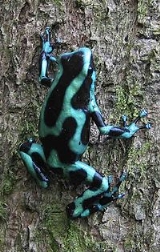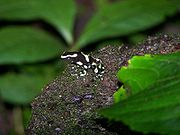
Green and Black Poison Dart Frog
Encyclopedia
Dendrobates auratus, also known as the green and black poison dart frog or the green and black poison arrow frog, and sometimes mint poison frog (not to be confused with the mint-green color morph of P. terribilis), is a brightly-colored member of the order Anura native to Central America
and north-western parts of South America
. It is one of the most variable of all poison dart frogs next to Dendrobates tinctorius
. It is considered to be of least concern from a conservation standpoint by the International Union for Conservation of Nature (IUCN).
 The green-and-black poison frog, while not the most toxic poison dart frog, is still a highly toxic animal. The very small amount of poison
The green-and-black poison frog, while not the most toxic poison dart frog, is still a highly toxic animal. The very small amount of poison
the frog possesses is still enough to make a human ill. Like most poison dart frogs, however, the green-and-black poison dart frog will only release its poison if it feels that it is threatened, and wild specimens can be handled if the human holding it is calm and relaxed. The green-and-black poison frog, as with all poison dart frogs, loses its toxicity in captivity due to a change in diet. This has led scientists to believe that the green-and-black poison frog actually takes its poison from the ants it feeds on.
.
D. auratus is semi-arboreal, hunting, courting, and sleeping in the trees, but as it is a small frog it cannot jump far enough to span the distances between trees, so it returns to the ground to travel. To assist in climing, the mint poison dart frog has small suckerlike discs on the ends of its toes, which create a slight suction as the frogs climb, making their grip mildly adhesive (although some individuals do have difficulty climbing).
s due to their small size, bright colors, and intreguing behavior. As with all frogs, they have permeable skin and should not be handled whenever possible. If it is imperative to move them, handling should be done with extreme care and with clean hands. Their small size makes them fearful of animals much larger than themselves, such as humans, and will attempt to escape if handled. To prevent escape, many frogkeepers move their auratus in fine-meshed nets or with cupped hands. A partly terrestrial, partly arboreal enclosure should also be provided. Auratus may be small, but they are very active and need suitably large terrariums (usually 100 x 60 x 60 centimetres) with a high level of humidity. Live plants should also be added to provide hiding places, and bromeliads in the event that the frogs breed.
Central America
Central America is the central geographic region of the Americas. It is the southernmost, isthmian portion of the North American continent, which connects with South America on the southeast. When considered part of the unified continental model, it is considered a subcontinent...
and north-western parts of South America
South America
South America is a continent situated in the Western Hemisphere, mostly in the Southern Hemisphere, with a relatively small portion in the Northern Hemisphere. The continent is also considered a subcontinent of the Americas. It is bordered on the west by the Pacific Ocean and on the north and east...
. It is one of the most variable of all poison dart frogs next to Dendrobates tinctorius
Dendrobates tinctorius
Dendrobates tinctorius, also known by the common name dyeing dart frog, is a species of poison dart frog. It is the third largest species, reaching lengths of...
. It is considered to be of least concern from a conservation standpoint by the International Union for Conservation of Nature (IUCN).
Poison

Poison
In the context of biology, poisons are substances that can cause disturbances to organisms, usually by chemical reaction or other activity on the molecular scale, when a sufficient quantity is absorbed by an organism....
the frog possesses is still enough to make a human ill. Like most poison dart frogs, however, the green-and-black poison dart frog will only release its poison if it feels that it is threatened, and wild specimens can be handled if the human holding it is calm and relaxed. The green-and-black poison frog, as with all poison dart frogs, loses its toxicity in captivity due to a change in diet. This has led scientists to believe that the green-and-black poison frog actually takes its poison from the ants it feeds on.
Description
The mint poison frog is in all ways an average poison dart frog. Males reach about three quarters of an inch long; females are slightly larger, up to an inch long or bigger. As the common name "mint poison dart frog" suggests, the green-and-black poison frog typically has mint-green coloration; however they can also be forest green, lime green, emerald green, turquoise, pale yellow, or even cobalt blue. Many also have splotches of dark colors, ranging from wood brown to black. The green-and-black poison frog is one of the most variable of all poison frogs in appearance. Some have black or brown splotches, others are dappled, or have "splashes" of black, like Oophaga sylvaticusDiablito
The Diablito is a species of frog in the Dendrobatidae family.It is found in Colombia and Ecuador.Its natural habitat is subtropical or tropical moist lowland forests.It is threatened by habitat loss.-Source:...
.
D. auratus is semi-arboreal, hunting, courting, and sleeping in the trees, but as it is a small frog it cannot jump far enough to span the distances between trees, so it returns to the ground to travel. To assist in climing, the mint poison dart frog has small suckerlike discs on the ends of its toes, which create a slight suction as the frogs climb, making their grip mildly adhesive (although some individuals do have difficulty climbing).
Reproduction
Like all poison dart frogs, green-and-black poison dart frogs gather in large groups before mating. They squabble over territories; eventually each individual male frog clears a small patch for himself. Females wander among the males, the latter then attempt to impress the former with their bird-like mating calls. Once a male has caught the attention of a female, he leads her to a site he has selected for egg deposition. The female lays her eggs, which he then fertilizes. In approximately 14 days, these hatch into tadpoles. Their parents (typically the male) then carry the tadpoles into the canopy; the tadpoles sticking to the mucus on their parents' backs. The parents then deposit their tadpoles into the small pools of water that accumulate in the center of bromeliads and guard the tadpoles while they feed on algae and small invertebrates that inhabit the tiny pool.As pets
Green-and-black poison dart frogs are popular exotic petExotic pet
An exotic pet is a rare or unusual animal pet, or an animal kept as a pet which is not commonly thought of as a pet.The definition is an evolving one; some rodents, reptiles, and amphibians have become firmly enough established in the world of animal fancy to no longer be considered exotic...
s due to their small size, bright colors, and intreguing behavior. As with all frogs, they have permeable skin and should not be handled whenever possible. If it is imperative to move them, handling should be done with extreme care and with clean hands. Their small size makes them fearful of animals much larger than themselves, such as humans, and will attempt to escape if handled. To prevent escape, many frogkeepers move their auratus in fine-meshed nets or with cupped hands. A partly terrestrial, partly arboreal enclosure should also be provided. Auratus may be small, but they are very active and need suitably large terrariums (usually 100 x 60 x 60 centimetres) with a high level of humidity. Live plants should also be added to provide hiding places, and bromeliads in the event that the frogs breed.

